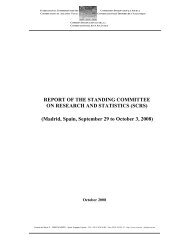E - Iccat
E - Iccat
E - Iccat
Create successful ePaper yourself
Turn your PDF publications into a flip-book with our unique Google optimized e-Paper software.
ICCAT REPORT 2012-2013 (I)<br />
Appendix 8 to ANNEX 9<br />
262<br />
Statement by the Observers from WWF to Panel 2<br />
The millennia-old bluefin tuna fishery in the Mediterranean entered a phase of rapid and intense deterioration the<br />
last decade of the 20 th Century, when the new practice of farming wild-caught tunas, formerly unknown in the<br />
Mediterranean, mushroomed without control. This generated a perverse overfishing spiral as the growing<br />
demand for live large tunas fuelled the massive development of the industrial purse seine fleets and their<br />
expansion over virtually all Mediterranean waters where the bluefin tuna gathered to reproduce.<br />
After several years of open mismanagement and reacting from the clear calls from science and civil society<br />
worldwide to avert an upcoming collapse of the fishery and the stock, ICCAT adopted in 2006 a first recovery<br />
plan for the species. This first plan still fell very short from following scientific advice and it has been<br />
increasingly strengthened and refined along the years - particularly since 2009, coinciding with a proposal to list<br />
the species in Appendix I of the CITES Convention. The current plan includes, among other aspects, a minimum<br />
landing size matching the size at maturity for the species, an open season for purse seine fleets of just one month<br />
a year, a TAC at 12,900 t (compared to 32,000 t in 2006), an ICCAT Regional Observer Programme (ROP), a<br />
Catch Documentation Scheme (the BCD), a fleet capacity reduction plan and a Scheme of Joint International<br />
Inspection. As a result, there is consensus in ICCAT that real catches (including the illegal ones) have<br />
substantially declined the last few years. However, there is still concern on the potential for illegal fishing due to<br />
overcapacity and control loopholes, as exemplified by the cases WWF has submitted to the ICCAT compliance<br />
Committee this year and several studies based on international trade suggesting real catches more than doubling<br />
reported ones.<br />
ICCAT SCRS has updated this year the 2010 stock assessment. Overall, ICCAT scientists warn that the<br />
assessment methodology currently used doesn’t satisfactorily address the substantial uncertainties in fisheries<br />
and biological data. The analyses point to a likely increase in the spawning biomass of the stock along the last<br />
few years, but the amplitude and speed of this recovery trend is deemed as “highly uncertain”. Based on forecast<br />
analysis ICCAT SCRS recommends keeping the TAC at current levels as it will likely allow the stock to<br />
increase and is consistent with the ICCAT goal to rebuild the stock by 2022. Besides, ICCAT SCRS<br />
recommends extending the current main management measures to the next three years (the next assessment is<br />
scheduled in 2015) as “a period of stabilization in the main management measures would allow SCRS to better<br />
estimate the amplitude and speed of recent trends in F and SSB in the coming years”.<br />
WWF calls on ICCAT CPCs to:<br />
1. Extend the current (2012) management measures, including the TAC at 12,900 t and the fishing seasons, to<br />
the period 2013-2015.<br />
ICCAT SCRS is extraordinarily clear in its last assessment on its advice to keep the current management<br />
measures (including catches at the current TAC of 12,900 t or a similar level) to meet the goal to achieve B MSY .<br />
Even if it acknowledges that a “slightly higher TAC may achieve the recovery by 2022” it warns that “this<br />
outcome needs to be confirmed by future data and analyses” as “the speed and magnitude of the rebuilding of the<br />
SSB (spawning stock biomass) remains highly uncertain.” Current signs of stock increase are –cautiouslyencouraging<br />
and show that good management pays even in the apparently most hopeless among fisheries. It’s<br />
been a long and huge concerted effort among all stakeholders to reach this point and it’s in the interest of the<br />
bluefin fishery, ICCAT and the global fisheries governance system to make the Atlantic bluefin a management<br />
success story after being the global icon for overfishing the last decade.<br />
2. Review and strengthen the current fishing capacity reduction plan to bring real catch capacity down to the<br />
level of fishing possibilities.<br />
ICCAT SCRS warns in its last bluefin tuna assessment that current capacity levels “could easily harvest catch<br />
volumes well in excess of the rebuilding strategy adopted by the Commission”. ICCAT first adopted a fleet<br />
capacity reduction plan for the bluefin tuna in 2008 (ICCAT Rec. 08-05) which was further refined in 2010<br />
(ICCAT Rec. 10-04). The current plan ends in 2013, when it’s assumed to have phased out all fishing<br />
overcapacity. However, a recent assessment (Tudela and Quílez-Badia, 2012) shows the current plan is based on<br />
catch rates per fleet segment which are strongly underestimated resulting in an end situation of still huge<br />
overcapacity (worth over 200% the TAC). This is consistent with the warning from the SCRS this year. WWF<br />
calls on ICCAT to extend the current capacity reduction plan to the next three-year period using updated, more<br />
realistic estimates of potential catch rates so as to ensure overcapacity is fully removed at the end of the period.

















